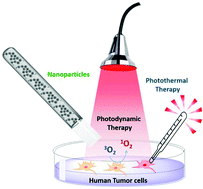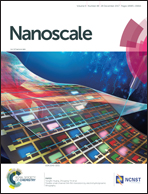Plasmon-mediated cancer phototherapy: the combined effect of thermal and photodynamic processes†
Abstract
A nanoplatform for simultaneous cellular imaging, and photodynamic and photothermal therapies has been designed and realized by embedding a purposely synthesized highly luminescent water soluble iridium(III) compound into gold core–silica shell nanoparticles. These multifunctionalities arise mainly from the photophysical properties of the cyclometalated complex: (i) the heavy atom promotes, through excited triplet state formation, energy transfer processes towards molecular oxygen, with the generation of 1O2 (photodynamic effect); (ii) the overlap of the iridium(III) complex emission band with the plasmonic resonance of gold nanostructures allows excitation energy transfer towards the metallic core (photothermal effect); (iii) the remarkable iridium(III) complex luminescence feature, which is preserved despite energy transfer processes, makes the whole system an efficient luminescent bio-probe (imaging). Photophysical and photothermal investigations have been carried out, whereas in vitro photo-cytotoxicity tests have been performed on human glioblastoma cells (U87MG), highlighting significant cancer cell death at a very low photosensitizer concentration (<0.5 μM), by means of a synergistic photodynamic and photothermal effect.



 Please wait while we load your content...
Please wait while we load your content...